- Services
Technology Capabilities
Technology Capabilities- Product Strategy & Experience DesignDefine software-driven value chains, create purposeful interactions, and develop new segments and offerings
- Digital Business TransformationAdvance your digital transformation journey.
- Intelligence EngineeringLeverage data and AI to transform products, operations, and outcomes.
- Software Product EngineeringCreate high-value products faster with AI-powered and human-driven engineering.
- Technology ModernizationTackle technology modernization with approaches that reduce risk and maximize impact.
- Embedded Engineering & IT/OT TransformationDevelop embedded software and hardware. Build IoT and IT/OT solutions.
- Industries
- GlobalLogic VelocityAI
- Insights
BlogsNovember 6, 2023GlobalLogicOntology – key Enabler of Next-Gen Technologies
Every big or mid-sized company has a proliferation of sites, edge devices, apps, and di...
 BlogsNovember 30, 2023GlobalLogic
BlogsNovember 30, 2023GlobalLogicSmartphone on Wheels
Over the past decade, cars have undergone a significant transformation to provide a mor...

- About
Published on December 10, 2023Leadership In Architecture – 3cs To Remember
ShareLet's start engineering impact together
GlobalLogic provides unique experience and expertise at the intersection of data, design, and engineering.
Get in touchTesting-as-a-ServiceTechnologyAs architects and technical people, we always gravitate towards the cool stuff, the in-things and everchanging landscape of technology. If Angular was hot a few years back, now React and Micro-front ends are the in-thing and we all want to know that.. Or if core AWS or Azure services was arcane 2-3 years back, it is now a given and instead everyone is looking for platforms on top of platforms. But in our own industry of engineering services, where we interact with our client technical counterparts and teams day in day out, we also need to develop skills beyond pure technical skills. We need to develop what I call 3Cs namely Communication, Compromise and Convergence. This blog article explains each of these 3Cs, why they are important, how to gain competency and mastery in these areas along with some personal examples.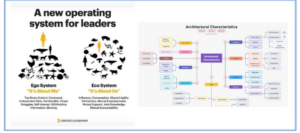
Communication is of course exchanging information through some medium. Now as an enterprise architect leader, why is this so important? A key part of the enterprise architect’s role is not just to create a design but to convince other stakeholders of that design —project managers, executives, developers, and policymakers. Since the stakeholders are several and are at different levels, your communication also
needs to be at different levels. While a CxO just needs a quick overview, a developer/lead would need technical implementation paths to the design while a project manager will want to know execution constraints for the design (costs and resources). In all of these, you need to know how to tell a story. In a million different ways.Communication of an enterprise architecture straddles a lot of areas. Figure 1 covers the broad areas that span a complete enterprise architecture.
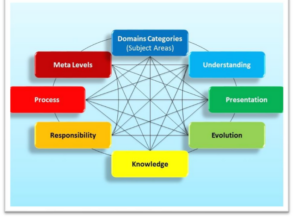
Figure 1: Eight key features of communicating an enterprise architecture
Source link: https://www.linkedin.com/pulse/convergence-architecture-roger-evernden/These areas are elaborated as follows: They specify paradigms, principles, protocols, and patterns that guide and inform the more detailed work. They may also specify the components and their configuration, but in a way that often allows a variety of alternative development, implementation, or operational decisions.
[Understanding]
Architects deal with a huge number and range of stakeholders – from a wide variety of backgrounds, and with very different requirements, concerns and viewpoints. Architects therefore need to be master’s at balancing these different perspectives and priorities, by taking everything into account and producing an architecture that excites and satisfies everyone (hopefully!). This means that everyone has a part to play; we all have shared responsibilities.[Responsibility]
Architects must have a broad – but often also a very deep – knowledge of many inter-related domains or subject areas.
[Domains]
• Architects must be able to scale their ideas and designs so that they can present information at a high, contextual level, while also being able to zoom into the details whenever necessary. They need to present information in different ways to each audience.
[Presentation]
• Some ideas need to be developed as archetypes or as more abstract classes.[Meta Levels]
• Architectural plans need to be adaptive, sustainable, and future proof. They need to take into account trends, allow for future options, and expect the unanticipated and not yet known![Evolution]
Architecture must follow a process – sometimes formal and procedural, but often informal and opportunistic – to cover all of the key steps, to involve all responsibilities, to ensure adequate governance for architectural guidelines or specifications, and to ensure that the target architectures are successfully delivered.
[Process]
And architects need to recognize that we can never control and plan everything; we can never. “know” everything; and therefore, architecture is always a process of learning.
[Knowledge]
There are tools that can help you become more effective at communication. Best-in-class organizations also create taxonomies, archetypes and standard ways/mediums of information so that communication becomes unambiguous and easy to comprehend. At GlobalLogic, for most written communication artifacts, we have reference templates, blueprints and cheat sheets that can help you on your way.
Onto the second C – Compromise. This seems a bit controversial. My experience over the years has been that – like in so many other areas – even in enterprise architecture, decisions and actions are dependent on the people and stakeholders in the process. Especially in our industry of engineering services, there is the customer stakeholder, the customer’s customer (end-user) and our own teams as people in the process. Each of these people bring in their own personal and experiential views and dimensions into the solutioning. And this may be result in significant divergence. While it is the job of an enterprise architect to discuss differences between stakeholders and iterate until a solution is found, often times we have to get into situations where trade-offs need to be made. This is what I mean by compromise. In these scenarios, as architects, our role needs to be to steer the various stakeholders to make decisions to move the project or solution forward. One useful tool I have found in this process has been the Pugh Matrix (which is a 6-sigma tool to document and help make trade-off decisions objectively). I recommend you learn to make use of this tool. An example of a simplified version of this tool is given below in Figure 2 where we compared a potential architecture tradeoff using the Pugh Matrix. The key part to understand here is that apart from the technical evaluation, as an enterprise architect, we should also recommend a holistic project decision so that we can get to a quicker agreement and resolve potential conflicts.
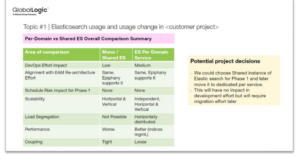
Figure 2: Using simplified Pugh Matrix for architectural decision making.
Source link: Internal GlobalLogic
Another important aspect to be aware of is that software and enterprise architecture is never permanent. It evolves, sometimes gets destroyed and gets rebuilt again. So, it is fluidic in nature. The skill of an enterprise architect lies in being able to handle this change. Newer paradigms of technology like microservices, micro front ends, DDD, cloud services and DevOps are all enablers for making enterprise.
architecture more and more fluidic. The third and probably most important C – is Convergence. In today’s day and age, technologies and
systems are rapidly converging. This is not only because of the rise of platforms but also because of business dynamics. There are a few examples of convergence in different industries in the table below.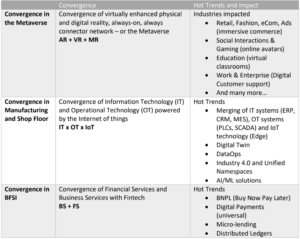
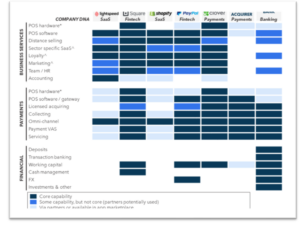
Figure 3: Convergence of FinTech and Ecommerce.
Source link: https://mrallenmiller.medium.com/the-great-convergence-how-fintech-and-ecommerce-are-changing-the-game 53885db62166
As techies and architects, it is important for us to keep track of and be aware of the convergence happening in various industries and their resultant impact on architecture and technology. Being in a services company like GlobalLogic helps us immensely because we work on and interact with different industry clients every day and so have a much earlier birds-eye view of upcoming trends in convergence.
So, to bring it all together for the 3Cs, here is my set of calls to action to gain architecture leadership and mastery.
✓ Hone your skills on Communication. Learn to present a technical concept at various levels of fidelity so that it becomes clear to different stakeholders. This comes through practice as well as learning from others you encounter during your interactions.
✓ Be aware that Architecture is not just about pure technical stuff, and that politics and differing viewpoints are always present. You need to look for these cues and be able to Compromise where needed while ensuring that the project moves forward. Pugh Matrix is a good tool I would recommend tackling Compromise.
✓ And finally, broaden your understanding and insight into developing shifts in various industries. One industry may have found a really great way to create new software, and this could be adapted in a new industry. If not now, this will happen sooner or later. Convergence of ideas, technologies and solutions is something that is more important than ever. So, the best way to become good at this is to read more, interact more and GL ITO is a breeding place where you can get a jumpstart on this vector.
“You never change your life until you step out of your comfort zone, change. begins at the end of your comfort zone.” ― Roy T. Bennett
